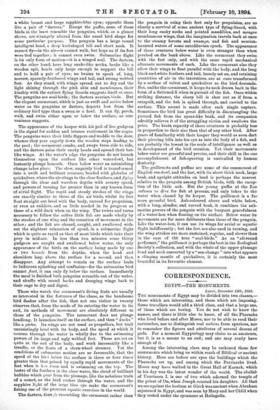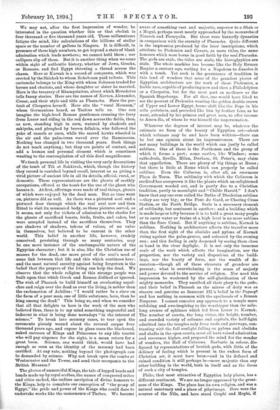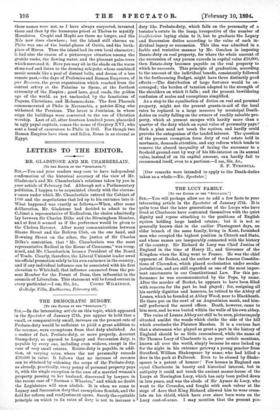CORRESPONDENCE.
EGYPT.—THE MONUMENTS.
Luxor, December 12th, 1893. THE monuments of Egypt may be divided into two classes,— those which are interesting, and those which are imposing. Some travellers would add a third class, and that a large one, of those which are boring. You do not wish to know the names, and there is little else to know, of all the Pharaohs who lived before and after Moses, nor to be able to read their cartonches, nor to distinguish real anticas from spurious, nor to remember the figures and attributes of several dozens of gods. For a moment Egyptology may claim us as amateurs, but it is as a means to an end; and one may easily have- enough of it.
Among the interesting class may be reckoned those few monuments which bring us within reach of Biblical or ancient history. Here are before our eyes the buildings which the- Pharaohs set up, and among which the Patriarchs lived. Moses may have walked in the Great Hall of Karnak, which in his day was the latest wonder of the world. The obelisk of Usurtasen I. is one of two which adorned the temple of the priest of On, when Joseph courted his daughter. All that- we see against the horizon at Giza was ancient when Abraham sojourned in Egypt, and was seen by Mary and her Child when they rested under the sycamore at Heliopolis. We may not, after the first impression of wonder, be interested in the question whether this or that obelisk is fonr thousand or five thousand years old. These millenniums fatigue the mind, like calculations of the billions of stellar space or the number of gallons in Niagara. It is difficult, in presence of these high numbers, to get beyond a state of blank admiration which leads nowhere ; we cannot hold them ; our -callipers slip of them. But it is another thing when we come within sight of authentic history, whether of Jews, Greeks, -or Romans, and find Egypt throwing a thread across the -chasm. Here at Karnak is a record of conquests, which was -erected by the Shishak to whom Rehoboam paid tribute. This cartonche belongs to the King with whom Solomon traded for horses and chariots, and whose daughter or sister he married. Here is the treasury of Rhampsinitus, about which Herodotus tells funny stories. Here are the names of Xerxes, Alexander, ',Cana; and their style and title as Pharaohs. Here the por- trait of Cleopatra herself. Here sits the "vocal Memnon," whom Germanicus heard, as Tacitus tells us, One can imagine the high-bred Roman gentleman crossing the ferry -from Luxor and riding in the red dawn across the fields, then, as now, standing high in corn, watered by shadoofs and sakiyehs, and ploughed by brown fellahin, who followed the yoke of camels or oxen, while the sacred hawks wheeled in the air and the palm-trees waved over the Ramesseum. Nothing has changed in two thousand years. Such things -do not teach anything ; but they are points of contact, and add a human and personal element which is sometimes wanting to the contemplation of all this dead magnificence.
We touch personal life in visiting the very early decorations of the tomb of Tih at Sakkitrah, which, though the history 'they record is vanished beyond recall, interest us as giving a vivid picture of ancient life in all its details, official, rural, or -domestic. These representations are the ghosts of earthly -occupations, offered at the tomb for the use of the ghost who haunts it. At first, offerings were made of real things, ghosts -of which were enjoyed by the dead man. But as time went -on, pictures did as well. As there was a pictured soul and a pictured door through which the real soul now and then flitted to visit its mummied body, so these pictures served, as it seems, not only for tickets of admission to the shades for the ghosts of sacrificed beasts, birds, fruits, and cakes, but were accepted instead of the sacrifices themselves. They are shadows of shadows, tokens of values, of no value in themselves, but believed to be current in the other world. This belief in another life, however, crudely -conceived, persisting through so many centuries, may be one more instance of the unchangeable nature of the Egyptian character ; but it is also, like the Christian use of masses for the dead, one more proof of the soul's need of :some link between that lifg and this which continues here : and the most natural security against being forgotten is the belief that the prayers of the living can help the dead. We -observe that the whole religion of this strange people was -built upon that which Greek and Roman disliked or ignored. The wish of Pharaoh to build himself an everlasting sepal- -dire and reign over the dead as over the living, is nobler than the exclamation of Achilles : "I would rather be a slave on the farm of a poor man, one of little substance, here, than be king among the dead." This being so, and when we consider that all that delights us here is the work of the men who believed thus, there is to my mind something ungrateful and indecent in what is being done nowadays "in the interest of science." To break into mummy cases, to tear open the cerements piously wound about the revered corpse four thousand years ago, and expose in glass cases the blackened, naked carcases of Kings and Princesses to any idle tourist who will pay sixpence for the sight, is a mean return for a :great boon. Science, one would think, would have had enough as soon as the identity of the mummy had been .certified. At any rate, nothing beyond the photograph can -be demanded by science. Why not break open the tombs at Westminster and the Tower, and send their occupants to the British Museum ?
The glories of unmerciful Kings, the tale of lopped heads and hands made up by royal scribes, the names of conquered tribes and cities sacked, the endless ascription of divine honours to the Kings, help to complete our conception of "the pcmp of Egypt," the pride and power of the Kings who could dare to undertake works like the monuments of Thebes. We become
aware of something vast and majestic, superior to a Shah or a Mogul, perhaps most nearly approached by the monarchs of Nineveh and Persepolis. But these were butterfly dynasties in comparison with the eternity of Pharaohs. Quite different is the impression produced by the later inscriptions, which attribute to Ptolemies and Cwsars, as mere titles, the same honours which were borne in good faith by the real Pharaohs. The gods are stale, the titles are stale, the hieroglyphics are stale. The whole machine has become like the Holy Roman Empire a century ago, waiting for a Napoleon to dissolve it with a touch. Yet such is the persistence of tradition in this land of wonders that some of the grandest pieces of Egyptian architecture are the work of these Ptolemies, a. feeble race, capable of producing now and then a Phila,delphus or a Cleopatra, but for the most part as mediocre as the Spanish Hapsburgs. For all that, one would have liked to see the poorest of Ptolemies wearing the golden double crown of Upper and Lower Egypt, borne aloft like the Pope in his sella gestatoria, and preceded like him by feather fans, as he went, attended by his princes and great men, to offer incense to Amen-Ha, of whom he was himself the impersonation.
Whatever the degrees of interest may be, whatever the estimate we form of the beauty of Egyptian art—about which volumes may be and have been written—there can be but one opinion about its impressiveness. There are not many buildings in the world which can justly be called sublime. One of these is the Parthenon and the group of which it forms a part; some castles, like Windsor; some cathedrals, Seville, Milan, Durham, St. Peter's, may claim that appellation. There are plenty of big things at Rome ; but there is little at Rome which can properly be called sublime. Even the Coliseum is, after all, an enormous Plaza de Toros. The sublimity with which the Coliseum is credited has overgrown it like the plants which an enlightened Government weeded out, and is partly due to a Christian tradition, partly to moonlight and " Childe Harold." I don't know that any one ever called the Baths of Diocletian sublime —they are very big ; or the Pont du Gard, or Charing Cross Station, or the Forth Bridge. Scale is a necessary element of sublimity, but sentiment is another ; and a building which is made large or lofty because it is to hold a great many people or to carry water or trains at a high level is no more sublime than the Suez Canal. But if anything is sublime, Karnak is sublime. Nothing in architecture affects the traveller more than the first sight of the obelisks and pylons of Karnak rising against the palm-groves, and coloured by the evening sun ; and this feeling is only deepened by seeing them close at hand in the clear daylight. It is not only the immense scale of the work which affects the imagination, nor the proportion, nor the variety and disposition of the build- ings, nor the beauty of form, nor the wealth of de- cora,tion—though all of these elements of grandeur are present ; what is overwhelming is the sense of majesty and power devoted to the service of religion. Nor need this impression be weakened by the self-glorification of these mighty monarchs. They ascribed all their glory to the gods; and their belief in Pharaoh as the mirror of deity was as sincere and genuine as Innocent III.'s belief in the Papacyl and has nothing in common with the apotheosis of a Roman Emperor. I cannot conceive any approach to a temple more
subduing and awe-inspiring to the worshipper than the mile- long avenue of sphinxes which led from Luxor to Karnak.
The number of courts, the long vistas, the height, number, and crowded variety of columns and capitals, the half-light admitted into the temples only from roofs and gateways, con- trasting with the full sunlight falling on pylons and obelisks and shafts in the open courts, must all have raised admiration and reverence higher, and prepared the mind for the wonder of wonders, the Hall of Columns. Barbaric in colour, dis- figured by representations of brutish gods, with little of the delicacy of feeling which is present in the rudest form of Christian art, it must have been—and in its defaced and rained condition it still perhaps is—more majestic than any other building in the world, both in itself and as the focus of such a city of temples.
Philze, that most attractive of Egyptian holy places, has a different sentiment. We are no longer oppressed by the great-
nem of the Kings. The place has its own religion, and was a natural sanctuary and a place of pilgrimage. Here were the sources of the Nile, and here stood Crophi and Mophi, if these names were not, as I have always suspected, invented there and then by the humorpus priest at Thebes to mystify Herodotus. Crophi and Mophi are there no longer, and the Nile now rises elsewhere ; but the island still charms us. Philze was one of the burial-places of Osiris, and the birth- place of Horns. Thus the island had its own local character; it had also the charm of a picturesque situation among the granite rocks, the flowing water, and the pleasant palm-trees which surround it. Here you may sit in the shade on the warm stone roof and listen to the droning sakiyehs, whose combined music sounds like a peal of distant bells, and dream of a less remote past,—the days of Ptolemies and Roman Emperors, of pax Romana, the great organisation which reached from the central artery at the Palatine to Syene, at the furthest extremity of the Empire ; good laws, good roads, the golden age of the world, as yet unclouded by the fanaticism of Pagans, Christians, and Mohammedans. The first Pharaoh commemorated at Philm is Nectanebis, a patriot-King who withstood the Persians. The latest is Justinian, in whose reign the buildings were converted to the use of Christian worship. Last of all, after fourteen hundred years, placarded in ugly papal capitals, comes the name of Gregory XVI , who sent a band of excavators to Philw in 1841. For though two Roman Empires have risen and fallen, Rome is as eternal as Egypt.








































 Previous page
Previous page